
What Are Supernovas?
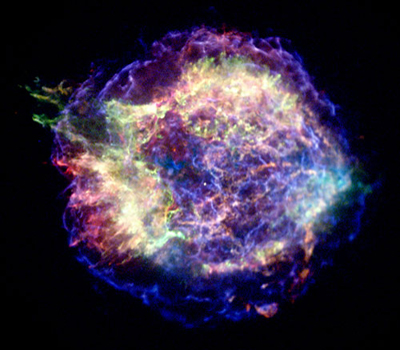
The X-ray photograph of Supernova Cassiopeia A at the left is an explosion of a star that reached the end of its life. On average, a supernova will occur about once every 50 years in a galaxy the size of our Milky Way. On a larger scale, a supernova explodes every second somewhere in the universe. How a star explodes depends on its mass and it will die in one of two ways:
-
Type I supernova - a star accumulates matter from a nearby neighbor until a runaway nuclear reaction ignites a gigantic explosion.
-
Type II supernova - a star runs out of nuclear fuel and collapses in on itself under its own gravity until it explodes.
Type Ia supernovas are thought to originate from a star swallowing a nearby white dwarf star in a binary star system. As the gas of the companion star accumulates into the white dwarf, the white dwarf is progressively compressed. This sets off a runaway nuclear reaction that eventually leads to a cataclysmic outburst. Astronomers use Type Ia supernovae as "standard candles" to measure cosmic distances because all Ia supernova blaze with equal brightness at their peaks.
There are also type Ib and Ic supernovas that undergo core-collapse (same as Type II supernovas explained below) but they have lost their outer hydrogen envelopes. All type I supernovas lack a hydrogen signature in their light spectra.
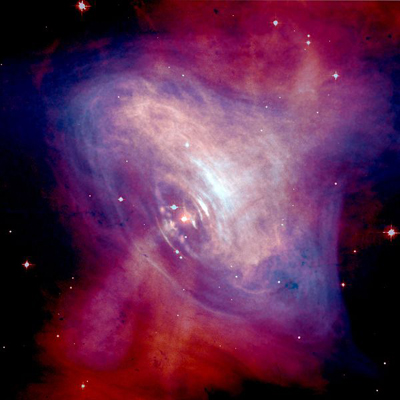
For Type II supernova to explode they must be considerably more massive than the sun (8 to 15 solar masses). They eventually run out of hydrogen and helium fuel in their core. (However, they do have enough mass and pressure to fuse carbon.) Here is the sequence of events for a Type II supernova:
-
Heavier elements build up at the center, and the star gradually becomes layered like an onion, with lighter elements toward the outside.
-
Once the star's core grows past a certain mass (the Chandrasekhar limit), the star begins to implode.
-
The core continues to heat up, becomes denser, and eventually the implosion bounces back off the core sending the outer material into space.
-
What is left is a super dense body called a neutron star. Pictured at the left is the Crab Nebula former supernova Type II neutron star. Near the center is a pulsar propelling particles almost at the speed of light.
There are also sub-categories of Type II supernovas based on their light curves. The light of Type II-L supernovas declines steadily after the explosion. Type II-P's light stays steady for a time before diminishing. All Type II supernovas "do" have a hydrogen signature in their spectra.
Supernovas remain bright for one to two months after exploding. Supernovas cannot be predicted with any accuracy. Normally, they are discovered after they are already in progress. Recent studies have found that all supernovas vibrate like giant loudspeakers and emit an audible hum before exploding. Top
Ia Supernovas Reveal "Dark Energy"

An example of a Type Ia Supernova is the bright spot at the lower left of the galaxy in the picture at the left. Since all Type Ia supernovas have about the same mass at the time of explosion, they all give off about the same amount of light. Therefore Ia supernovas are extremely "unique" because they all have the same maximum brightness at their peak just after they explode. Type Ia supernovas that exploded when the universe was half its present age behave the same as current ones do today. So the "peak brightness" can be used as a "standard candle".
Type Ia supernovas are superb candles - stellar explosions so bright that for a few days they can be brighter than entire galaxies. Therefore how bright (or dim) they appear reveals their distance. A far away supernova can be compared to a relatively close one (whose distance is known by other means) which yields a very good estimate of the far supernova's distance. Since we know the speed of light (c), dividing the distance by "c" equals their age.
Saul Perlmutter, Professor at University of California, Berkeley and Nobel Prize winner, developed a technique to calibrate all Ia supernovas to a standard size as shown in the graph to the left below. "Simply by stretching the time scales of
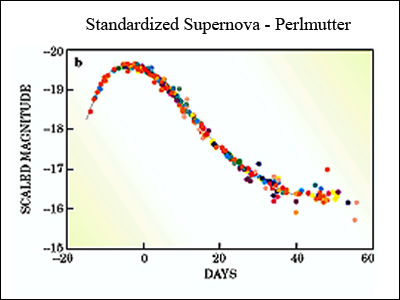
individual light curves to fit the norm, and then scaling the brightness by an amount determined by the required time stretch, one gets all the type Ia light curves to match" says Perlmutter. "The detailed uniformity of the type Ia supernovas implies that they must have some common triggering mechanism." Dots of the same color represent data from each supernova plotted. The data fit the standard curve extremely well.
Using the Perlmutter calibration technique, if a Ia supernova has a redshift that is dimmer than expected, that supernova must be farther away than thought. Its light has taken longer to reach us, and so the universe must have taken longer to grow to its current size. Therefore, the expansion rate of the universe must have been slower in the past than expected. In fact, the distant supernovas are dim enough that the expansion of the universe must have accelerated to have caught up with its current expansion rate.
Instead of slowing down as everyone had expected, the dimness of the supernovas showed that they were 10% to 15% farther out than anticipated, indicating that expansion had been accelerating over billions of years. In January 1998, the Berkeley Supernova Cosmology Project lead by Perlmutter presented the first evidence that the expansion was accelerating and that the acceleration was due to "dark energy", a new form of cosmic energy. See the Dark Energy page. Shortly thereafter, the High-z Supernova Search Team from Australia independently announced that they had come up with the same results. Both shared the 2011 Nobel Prize in Physics for this amazing discovery. The discovery that the universe is expanding at an accelerated rate was monumental and has since been verified by several other techniques. Top
What Are Pulsars?
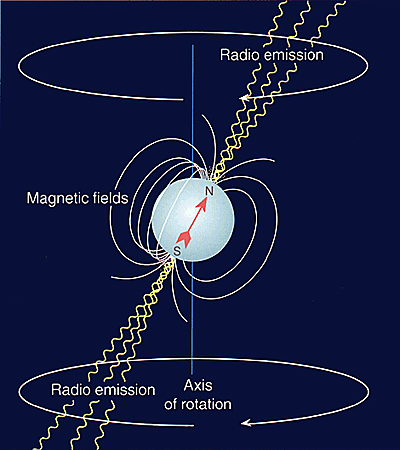
When a Type II Supernova has used up all its nuclear fuel it implodes into a small, super dense neutron star. The neutron star's gravity is so strong that its electrons have been forced into the protons in the atomic nuclei forming neutrons. A neutron star has enormous density; it is only about 12 to 18 miles in diameter yet it weighs as much as our sun.
The word "pulsar" is a shortened version of "pulsating star" and was coined in 1968. A pulsar is a rapidly rotating neutron star with a strong magnetic field. See the pulsar diagram at the left. In the strong magnetic fields, electrically charged particles move along field lines. At the magnetic poles, charged particles escape in two cone shaped beams, an upper and lower beam. Radio waves are also emitted from the magnetic poles.
Since the magnetic axis (red arrow) is tilted with respect to the axis of rotation (blue vertical line), the two beams of radio emission sweep across space like a lighthouse beam. The radiation can only be observed when the emission beam is pointing towards the earth. Each time one of the beams points towards the earth a radio pulse can be recorded. The observed periods of a pulsar's emission range from 1.4 milliseconds to 8.5 full seconds. There are over 2,000 known pulsars.
A binary pulsar is a pulsar with a secondary companion, often a white dwarf or another neutron star. In one binary, the companion star is also a pulsar. Although the binary companion to a pulsar is usually difficult or impossible to observe, the timing of the pulses from the pulsar can be measured with extraordinary accuracy by radio telescopes. The neutron star retains most of its
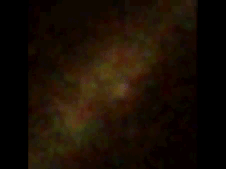
original angular momentum and with a tiny radius, it has an extremely high rotational speed. Some pulsars spin several hundred revolutions per second.
The first binary pulsar, PSR B1913+16, was discovered in 1974 by Russell Hulse and Joseph Taylor, Jr. at the Arecibo Radio Telescope Observatory in San Juan, Puerto Rico operated by Cornell University. The Hulse Taylor binary pulsar has been observed continuously since its discovery. In fact its orbiting period has decreased just as predicted by General Relativity.
Einstein’s theory of General Relativity predicts that two stars moving very fast and very close together should emit large amounts of Gravitational Waves. Gravitational Waves should carry away some orbital energy and cause the two stars to draw closer together. Their orbits should shrink and their orbiting period should shorten. The Hulse Taylor pulsar orbiting period has decreased exactly as predicted by Relativity. For the pulsar binary discovery and shortened binary orbiting period verification of Einstein's theory, Taylor and Hulse won the 1993 Nobel Prize in Physics.
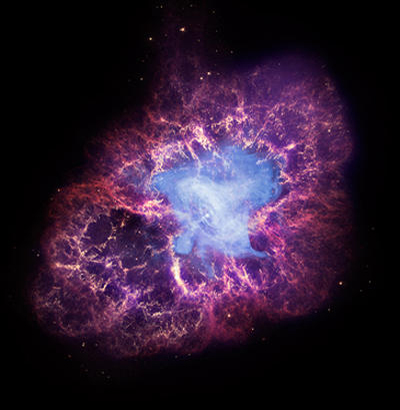
The Vela Pulsar shown at the above left is an actual gamma ray recording. The image shows pulsed gamma rays as recorded by the Fermi Gamma Ray Space Telescope. The theory behind how pulsars emit their radiation is still in its infancy even after forty years of study. Scientists do not fully understand the physics behind pulsar radiation. Recent measurements of the energies released by a pulsar are about an order of magnitude greater than models predict.
The Crab Nebula (shown at the left) is the spectacular remains of a massive star that became a Type II Supernova in the year 1054. The explosion was so bright that its brilliance was recorded by the Indian, Chinese, Japanese and Arab astronomers of the day. The collapsed core of the neutron star contains a pulsar (blue image in the center) discovered in 1969. The pulsar is only 18 miles in diameter but pumps out enormous amounts of energy, making the nebula 75,000 times brighter than the sun. Images taken several years apart indicate that the Crab Nebula is currently expanding outwards about 1,000 miles per second.
This combination image of the Crab Nebula shows X-rays from the pulsar in the center of the nebula in "blue", visible light in "red and yellow", and infrared radiation from the cataclysmic supernova explosion in "purple". The optical image is from the Hubble Space Telescope, the infrared image from the Spitzer Space Telescope, and the X-ray image from the Chandra X-ray Observatory.
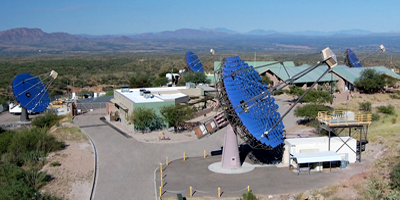
Gamma Rays From Crab Nebula "Off The Charts". In October of 2011, VERITAS astrophysicists reported gamma rays with energies far greater than current theoretical models predict from the Crab Nebula pulsar. The pulsed gamma rays had energies between 100 and 400 billion electron volts (GeV), far higher than the 25 GeV previously detected. The VERITAS (Very Energetic Radiation Imaging Telescope Array System) Project is a ground based gamma-ray observatory located at the Fred Lawrence Whipple Observatory in southern Arizona. See the picture at the left. The VERITAS four 12 meter telescope system is designed to study very high energy (VHE) gamma rays, those with energies above 100 GeV. Models of pulsar emissions to explain earlier observations do not explain the current VERITAS results.
Astrophysicists have a general picture of what causes pulsar emissions. Electromagnetic forces created by a neutron star's rapidly rotating magnetic field (Crab Nebula's is 30 times a second) accelerate charged particles to near the speed of light, producing radiation over a broad spectrum. The models predicted an "exponential" decay of the emission spectrum above 10 GeV. So it came as a real surprise when pulsed gamma-ray emissions at energies above 100 GeV were found. Prior to the current Crab results, a phenomenon known as curvature radiation was the leading explanation for the Crab's gamma-ray emissions. Curvature radiation is produced when a high energy charged particle moves along a curved magnetic field. However, this mechanism cannot account for gamma rays with energies above 100 GeV.
Another possible scenario could be a process known as Inverse Compton Scattering, which involves energy transfer from a charged particle (an electron) to a photon. This seems to be a more likely general scenario, but the details of how this would work are unknown. The pulsar radiation mystery continues. Top
Super Supernovas
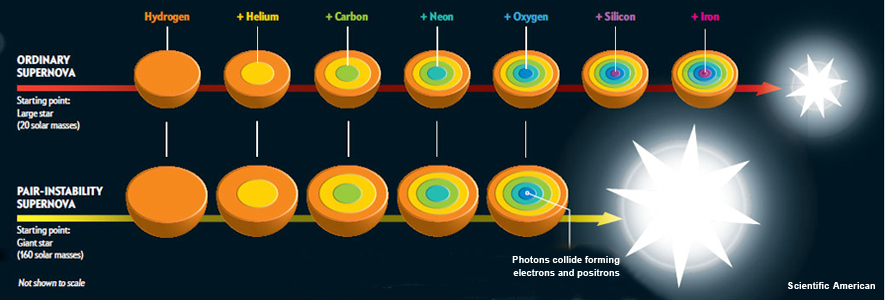
Shri Kulkarni, Professor of Astronomy at Caltech, and his team have been hunting for super-supernovas as part of the Palomar Transient Project. They have been finding a super-supernova about every two weeks. Statistically that means that one in every 10,000 normal supernovas is a super-supernova. Super-supernovas are about ten times brighter than normal supernovas when they explode and much bluer.
Historically, astrophysicists believed that massive stars could not grow beyond 100 solar masses and could not explode. Theorists believed that massive stars would gradually shrink down to about 20 solar masses by expelling huge amounts of stellar wind. However, the Palomar team has found stars as big as 140 solar masses and believe there could be some as big as 200 solar masses. These super big supernovas are from the early universe and are composed of mainly hydrogen. Stars that are newer and contain heavier elements inherited from earlier supernovas, ignite sooner and never get to grow into giants.
The chart above from the June, 2012 issue of Scientific American shows how a typical Ia supernova of 20 solar masses evolves. As the core ages, it condenses and a series of heavier elements are formed in an "onion-like" fashion. First, helium is formed, then carbon, neon, oxygen and so on until iron forms in the central core. This extended process may take a million or a billion years. The extreme heat and density finally triggers a runaway nuclear reaction that leads to a cataclysmic explosion.
Super Supernovas are now formally called Super Luminous Supernovae (SLSN). It is believed that Super Luminous Supernovae explode stimulated by a completely different process called "pair instability". In a hyper giant, the core condenses and heats up without becoming extremely dense. When it gets to the oxygen formation stage, instead of fusion, nuclei and electrons emit very energetic photons in the gamma-ray range. When two high powered pure energy photons collide, the collision produces a pair of real particles - an electron and a positron (a particle and its anti-particle). Remember that Einstein's equation, E = mc^2, says that energy and mass can be converted into one another. Since photons (which are pure energy) are converted into mass (physical particles), the star's internal pressure drops dramatically. The internal pressure is what kept the star from collapsing up to this point in time, but now after the pressure release, the star contracts dramatically. This causes the density to shoot up, the oxygen fuses, causing a runaway nuclear fusion reaction. Whereas a normal supernova leaves behind a neutron star, this reaction is so powerful that the star completely obliterates itself leaving behind only a super fast expanding cloud of extremely hot gases. This reaction is called a "pair instability" explosion, the pair being the generation of the electron and positron. This is the process that generates a SLSN explosion 10 times the luminosity of a standard supernova. For more information on SLSN see the Super Luminous Supernovae article. Top
What Are Quasars?
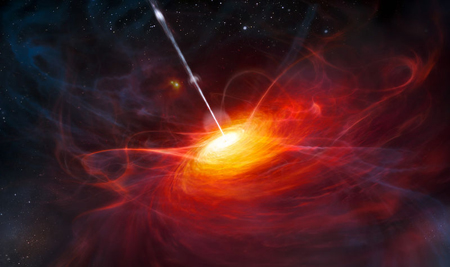
In the 1960s there were observations that there were stellar objects that emitted radio waves which were thought to be stars that had unusual optical spectra. In the 1960 optical images, quasars looked like single points of light indistinguishable from faint stars. Finally it was recognized that the spectra lines had large Doppler shifts suggesting velocities that were fractions of the speed of light. These objects were named "Quasi-stellar Radio Sources", meaning "star-like radio sources", which was soon abbreviated to quasars. At the left is an artist's conception of a quasar.
Quasars belong to a family of stellar objects known as "Active Galactic Nuclei" or AGN. AGN all have a powerful energy release from a small area in the center of their galaxy, much bigger than what ordinary stars, including supernovae and neutron stars, produce. A quasar is a compact region in the
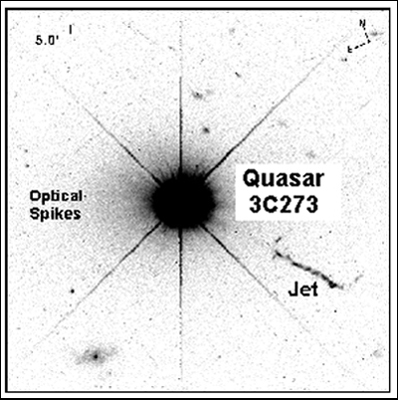
center of a massive galaxy that surrounds the galaxy's central supermassive black hole. Its size may be as great as 10,000 times the radius of the central galaxy's black hole. The quasar is powered by the accretion disc around the centralized black hole. Note that the quasar's jet comes from the edge of the accretion disc, rather than from the center (which would also be the center of the black hole). Most quasar radiation exceeds the luminous output of average size galaxies. However, they appear star like in ordinary telescopic photographs because the light from their nucleus dominates the light from the surrounding galaxy.
Quasars are the most luminous, powerful, and energetic objects in the universe. They inhabit the centers of active young galaxies and emit up to a thousand times the energy output of our Milky Way. Quasars have a very high redshift, which is a result of the expansion of the universe. The implication of the large redshift is that quasars are very distant, meaning they are objects from much earlier in the universe's history. Quasars are about the same size as our Solar System. This implies a humongous energy density. Shown at the left and also directly below is the original and brightest quasar seen from earth - 3C273. 3C273 is located in the Orion Constellation, but is about 2.4 billion light years away (redshift = 0.158).
Since light cannot escape the super massive black holes that are at the center of
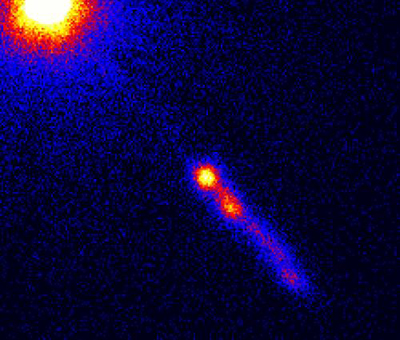
quasars, the escaping light energy is actually generated outside the event horizon of the black hole by gravitational stresses and the immense friction of incoming material. The material falling into the central black hole's gravity field is unlikely to fall directly into the black hole. This matter will likely have some angular momentum of its own that will cause the matter to collect in the accretion disc so that angular momentum is conserved. See Accretion Disks. Several dozen nearby large galaxies have been shown to contain a central black hole in their nuclei with no sign of a quasar nucleus. It is thought that all large galaxies have a supermassive black hole at their center, but only a small fraction emit powerful radiation and are seen as quasars. Quasars may also be ignited (or re-ignited) from normal galaxies when they ingest a fresh source of matter.
The spectra of quasars are quite different from those of ordinary galaxies, showing broad emission lines of gas excited to high levels, and an underlying blue continuous spectrum lacking the absorption lines from ordinary stars. The beams of radiation from material moving close to the speed of light means that the jet's light has been boosted such that it overwhelms everything else (even the powerful emission lines from the nucleus). Also, the variability in light output shows that most of the radiation must be coming from tiny regions, no more than light-hours in size. Otherwise, we couldn't see the objects vary as rapidly as we do, because our view of the whole object would be smeared by the time it takes light to cross it. Top
Quasars Are Dying
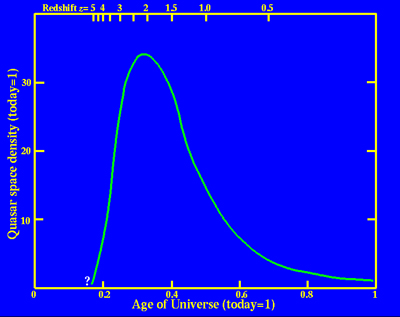
The chart at the left was published in a paper by Bill Keel, Professor Of Physics and Astronomy at the University Of Alabama. The scale on the bottom of the chart is time, but it can also be redshift as shown at the top of the chart. Looking at very distant objects in the universe is equivalent to looking back in time because of the constant speed of light in a vacuum. The number of quasars peaks at a redshift of about 2.25, which was about 3 billion light years ago.
The oldest quasar from the Sloan Digital Sky Survey (SDSS) is one with a redshift of 6.4 which was about 800,000 years after the Big Bang. At a redshift of about 4.0 there was a rapid increase of quasars. About this time early galaxies formed, collected enough material to make a fairly massive black hole, and had enough massive stars in its immediate neighborhood to devour and produce the heavy elements as seen in quasar spectra.
The first stars, forming from pure hydrogen and helium, were quite different from the ones we see today. The first stars were very massive and hot, exploding with more violence than today's supernovae. These stars, with masses hundreds of times larger than our sun, would have scattered their make up of heavier elements very widely as each exploded. These explosions would have destroyed the surrounding gas clouds and forced galaxy formation to start over. The great abundance of quasars in the early universe is consistent with the notion that a quasar shuts off when its black hole engine has consumed the fuel surrounding the host galaxy. In the early universe there most likely was more mass accessible to black holes than today because much of it has already been consumed. As the hungry black holes of the early quasars ran out of local fuel, they eventually shut down. Today there are vast voids between galaxies and little food for the massive black holes, which has caused most of the quasars to have been shut down for some time. To see a lot of burning quasars, we have to look a considerable way back in time. Top
Quasars Used For Research
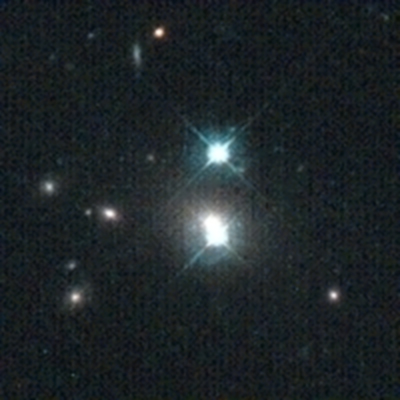
Quasars, the brightest objects in the universe, can be used as research tools to study objects in the distant universe through gravitational lensing and other techniques. One of the successes of Einstein's general theory of relativity was the prediction of the "bending of light" by a massive object (such as the sun). See the gravitational lensing section. The light from a distant quasar can also find itself bent by the curvature of space-time when passing around massive objects such as galaxies or clusters of galaxies.
Mass that bends quasar light can be normal mass or dark matter (a better name would be transparent matter). A significant "proof" of dark matter comes from carefully plotting the way that light from distant images, such as quasars, is distorted by galaxies. Using this technique, it is possible to quite accurately map where dark matter is located and to estimate its mass.
The photo to the left shows two images of a distant quasar (0957+561 in Ursa Major) also from the paper by Bill Keel. Only the top image is a real quasar. The bottom one is formed by gravitational lensing and is a false image. Astronomers can tell that both images are from the same quasar because both have identical spectra. Q0957, discovered in 1979, was the first quasar observed to have gravitational lensing. So far there have been about 50 more quasars discovered that exhibit gravitational lensing.
Analysis of quasar data can tell us how large the force of dark energy might be and measure the Hubble constant independent of traditional techniques. Using the light from 50,000 quasars and a new technique called "baryon acoustic oscillations" (BAO), cosmologists on the BOSS team have been able to measure the early deceleration and recent acceleration of the universe. See the BOSS Project as part of the SDSS Program. Top
Monster Quasar Discovered
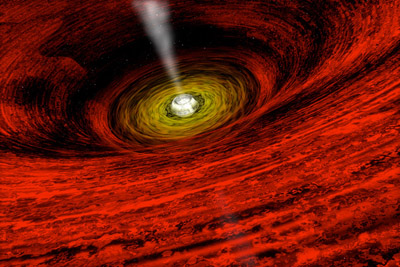
In December of 2012, astrophysicists discovered a quasar, SDSS J1106+1939, with the most energetic outflow ever. The rate that energy is spewing out from this quasar is equivalent to two trillion times the power output of the sun at a speed of 5,000 miles per second. . The black hole at the heart of the quasar is massive, estimated to be a thousand times heavier than the black hole in the Milky Way.
The quasar's outflow is at least five times more powerful than the previous record holder. The larger the quasar, the more material it can attract, the higher the speed it can accelerate it, and the further it can eject the material. The outflow jet is estimated to be about a thousand light years away from the black hole at the heart of the quasar.
Using the north-facing Keck telescope in Hawaii, and the south-facing Very Large Telescope (VLT) in Paranal, Chile, the researchers observed more than 100 quasars. Quasars are compact but highly luminous objects - so luminous that they can be studied in detail using ground based telescopes despite being vast distances away. Scientists believe that quasars contain black holes at their centers and that the immense gravitational force exerted by the black hole is extremely efficient at converting matter in its vicinity into light.